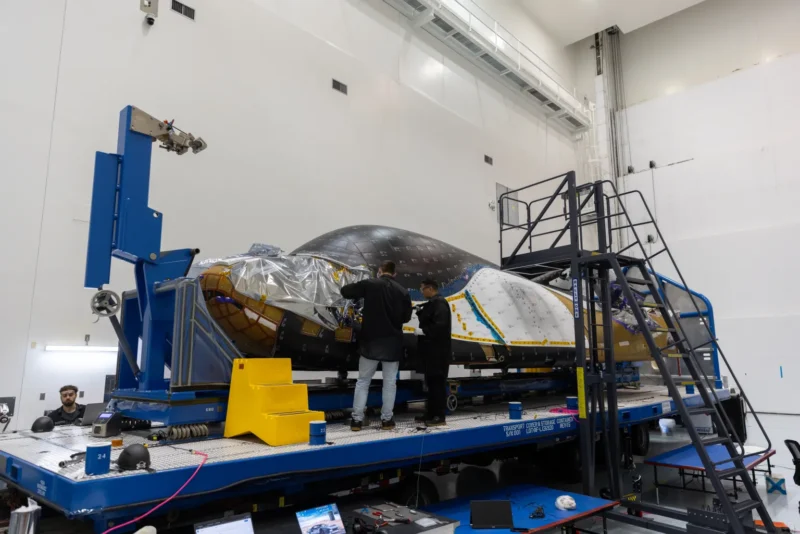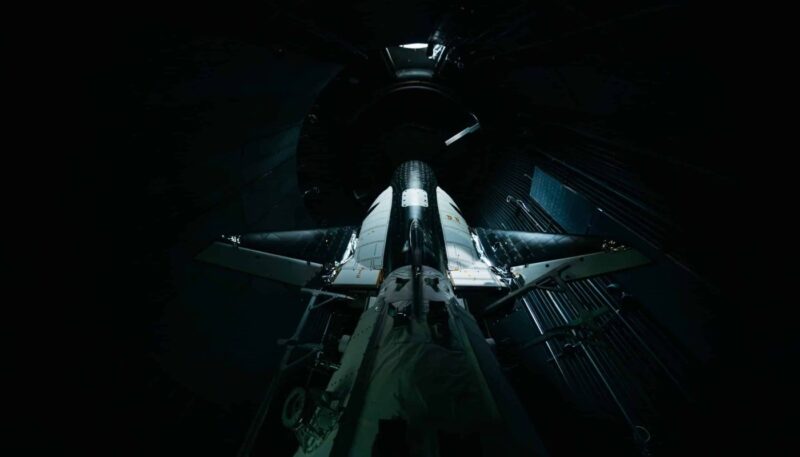
New spaceplane will be a ferry to the space station
Tenacity – the first model of the Dream Chaser spaceplane from Sierra Space – arrived at Florida’s Kennedy Space Center last week (May 20, 2024), where it will finish prepping for its maiden voyage. The vessel will fly atop a United Launch Alliance (ULA) Vulcan Centaur launch vehicle. For its first mission, which is not yet scheduled, it will carry about 8,500 pounds (3,850 kg) to the International Space Station. NASA has contracted with Sierra Space for seven cargo missions to the space station. Sierra Space also has plans for a second version of its Dream Chaser spaceplane, which will carry crew to low-Earth orbit destinations.
In a news release on MAay 20, 2024, NASA said the craft will expand the agency’s commercial low-Earth orbit resupply program. They described the punishing testing the tiny 30-by-15-foot (9-by-4.5-meter) craft has already undergone at the Neil Armstrong Test Facility:
Before arriving at Kennedy, the spaceplane and its cargo module underwent vibration testing atop the world’s highest capacity and most powerful spacecraft shaker system inside the agency’s Space Environments Complex, exposing the stack to vibrations like those it will experience during launch and re-entry to the Earth’s atmosphere. Following vibration testing, the duo moved to NASA’s In-Space Propulsion Facility and was exposed to low ambient pressures and temperatures ranging from -150 to 300 degrees Fahrenheit (-101 to 148 degrees Celsius).
NASA has yet to announce a date for the launch. When in full swing, the Dream Chaser Tenacity (aka the DC-100) will carry up to 12,000 pounds (5,445 kg) to low-Earth orbit.
Dream Chaser will be 1st private spaceplane to fly
Spaceplanes have been around for decades, with NASA’s space shuttle the most memorable. But there are others flying today, including the US Space Force’s X-37B and a Chinese version with a starkly utilitarian name: the Reusable Experimental Spacecraft.
There was also a Soviet version – the Buran – that never made it off the ground.
All of them bear a striking resemblance to the space shuttle, especially the Soviet version. Dream Chaser is no exception. It features a bright, white body with a sleek swept delta-wing design and an underbelly covered in black, heat-resistant tiles. And Dream Chaser, too, can fly.
Forbes described the craft this way in a 2020 article:
It is a lifting body with winglets that can land on any runway in the world measuring at least 10,000 feet (3 km) in length. In fact, with retirement of the Space Shuttle nearly a decade ago, Dream Chaser is the only spacecraft NASA currently funds that is capable of maneuvering within the atmosphere.

Dream Chaser’s sidekick can take out the trash
Dream Chaser also has a sidecar, the Shooting Star cargo module. Sierra Space said it can increase their spaceplane’s cargo capacity by thousands of pounds:
Shooting Star adds a service for NASA to send additional critical science, food and cargo to the space station. Crews can access the Shooting Star via the aft hatch, berthing to the space station. Traveling through the Shooting Star takes them to the forward portion where they can open the hatch and gain access to the Dream Chaser. When attached to the space station, Shooting Star provides a normal cabin environment for astronauts to work, and a prime location for cargo to be removed and placed onto the station after berthing.
Shooting Star carries up to 7,000 pounds (3,175 kg) of cargo. The module – which sports external mounting points for three additional cargo containers – doesn’t survive re-entry into the atmosphere after a mission. Instead, it’s loaded with tons of garbage that vaporize with the module during its fiery descent.
Bottom line: Dream Chaser Tenacity, an uncrewed spaceplane from Sierra Space, arrived in Florida on May 20, 2024, to prepare for its first cargo delivery mission to the International Space Station.
Read more: X-37B spaceplane launched atop SpaceX Falcon Heavy
The post Dream Chaser spaceplane prepping for 1st launch first appeared on EarthSky.
from EarthSky https://ift.tt/A1IE9fD

New spaceplane will be a ferry to the space station
Tenacity – the first model of the Dream Chaser spaceplane from Sierra Space – arrived at Florida’s Kennedy Space Center last week (May 20, 2024), where it will finish prepping for its maiden voyage. The vessel will fly atop a United Launch Alliance (ULA) Vulcan Centaur launch vehicle. For its first mission, which is not yet scheduled, it will carry about 8,500 pounds (3,850 kg) to the International Space Station. NASA has contracted with Sierra Space for seven cargo missions to the space station. Sierra Space also has plans for a second version of its Dream Chaser spaceplane, which will carry crew to low-Earth orbit destinations.
In a news release on MAay 20, 2024, NASA said the craft will expand the agency’s commercial low-Earth orbit resupply program. They described the punishing testing the tiny 30-by-15-foot (9-by-4.5-meter) craft has already undergone at the Neil Armstrong Test Facility:
Before arriving at Kennedy, the spaceplane and its cargo module underwent vibration testing atop the world’s highest capacity and most powerful spacecraft shaker system inside the agency’s Space Environments Complex, exposing the stack to vibrations like those it will experience during launch and re-entry to the Earth’s atmosphere. Following vibration testing, the duo moved to NASA’s In-Space Propulsion Facility and was exposed to low ambient pressures and temperatures ranging from -150 to 300 degrees Fahrenheit (-101 to 148 degrees Celsius).
NASA has yet to announce a date for the launch. When in full swing, the Dream Chaser Tenacity (aka the DC-100) will carry up to 12,000 pounds (5,445 kg) to low-Earth orbit.
Dream Chaser will be 1st private spaceplane to fly
Spaceplanes have been around for decades, with NASA’s space shuttle the most memorable. But there are others flying today, including the US Space Force’s X-37B and a Chinese version with a starkly utilitarian name: the Reusable Experimental Spacecraft.
There was also a Soviet version – the Buran – that never made it off the ground.
All of them bear a striking resemblance to the space shuttle, especially the Soviet version. Dream Chaser is no exception. It features a bright, white body with a sleek swept delta-wing design and an underbelly covered in black, heat-resistant tiles. And Dream Chaser, too, can fly.
Forbes described the craft this way in a 2020 article:
It is a lifting body with winglets that can land on any runway in the world measuring at least 10,000 feet (3 km) in length. In fact, with retirement of the Space Shuttle nearly a decade ago, Dream Chaser is the only spacecraft NASA currently funds that is capable of maneuvering within the atmosphere.

Dream Chaser’s sidekick can take out the trash
Dream Chaser also has a sidecar, the Shooting Star cargo module. Sierra Space said it can increase their spaceplane’s cargo capacity by thousands of pounds:
Shooting Star adds a service for NASA to send additional critical science, food and cargo to the space station. Crews can access the Shooting Star via the aft hatch, berthing to the space station. Traveling through the Shooting Star takes them to the forward portion where they can open the hatch and gain access to the Dream Chaser. When attached to the space station, Shooting Star provides a normal cabin environment for astronauts to work, and a prime location for cargo to be removed and placed onto the station after berthing.
Shooting Star carries up to 7,000 pounds (3,175 kg) of cargo. The module – which sports external mounting points for three additional cargo containers – doesn’t survive re-entry into the atmosphere after a mission. Instead, it’s loaded with tons of garbage that vaporize with the module during its fiery descent.
Bottom line: Dream Chaser Tenacity, an uncrewed spaceplane from Sierra Space, arrived in Florida on May 20, 2024, to prepare for its first cargo delivery mission to the International Space Station.
Read more: X-37B spaceplane launched atop SpaceX Falcon Heavy
The post Dream Chaser spaceplane prepping for 1st launch first appeared on EarthSky.
from EarthSky https://ift.tt/A1IE9fD

Aucun commentaire:
Enregistrer un commentaire